
|   |

|   |
Khajuraho Festival of Dances - Dr. Sunil Kothari e-mail: sunilkothari1933@gmail.com Pics: Dr Manish Jhabak March 10, 2013 Now in its 39th year, Khajuraho Festival of dances has added several features along with the festival. When one approached the festival venue located on the Western complex of Chandella temples, one entered into an area which covered several arts. Right from the delicious variety of food of Madhya Pradesh, one moved on to see the looms, weavers weaving amazing patterns on saris, block prints, then a potter, who carved out beautiful shapes of earthen wares. A store next to it had publications on art. From there on one entered the Art Mart, a welcome addition for tourists to buy paintings. Adjacent to it was an exhibition of paintings by artists from Madhya Pradesh, arranged in an eye catching manner. But lo and behold! Soon after that, you face a mandapa titled Nepathya. At its entrance were life size mannequins of Kathakali characters in their full regalia. With symbolic make-up of paccha, katti, kari, chokanna thaadi (beards), with their magnificent crowns, they invited you to enter the world of gods and demons, and as it were they walked the earth again! On walls were hung costumes of Kathakali characters, ornaments, scarves with mirrors at the end, the gold coloured belts, ornaments for the waist, bangles, earrings, crowns, cloth for lower garment, jackets, interspersed with other life size statues of characters from the forest, with detailed descriptions given in labels. Facing them were statues of Mohini in its enchanting beauty, edakka instrument, maddalam and ornaments. In the centre was a round shrine where a painter was drawing dhuli chitra, painting with dry colours of the Goddesses, and the surrounding walls had photographs of Ottan Thullal and its variations, of Krishnattam, with characters like Devaki in a state of advanced pregnancy, Satyabhama, Krishna astride Garuda, Gopis dancing with Krishna and strange though it may seem, the Gopis had their faces outlined with chutti, white beard! 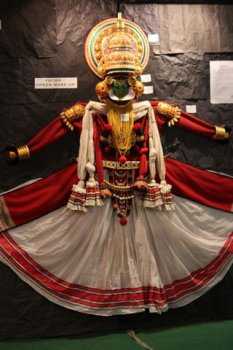
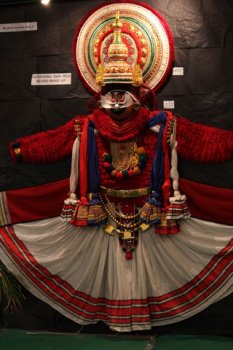
Both Kathakali exponent Kalamandalam Piyal from Kolkata and Mohiniattam exponent Mandakini Trivedi from Mumbai, who had been commissioned to mount this exhibition, had taken pains to bring alive the world of Kathakali along with an exquisite small book on Kathakali written by them. Some colourful paintings of make-up on bamboo were excellent. The entire concept is to usher the onlooker into the mysterious world of dance. Previous year, the Sattriya dance form and its environs of Assam monasteries, Sattras, were introduced. For the coming year, the organizers are planning to mount similar exhibition introducing Odissi dance. The organizers could make arrangements for guided tours and keep timings between 10am and 12 noon and again from 4pm onwards, so that tourists who visit temples can go there before it gets too hot. 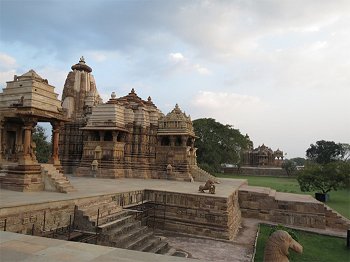
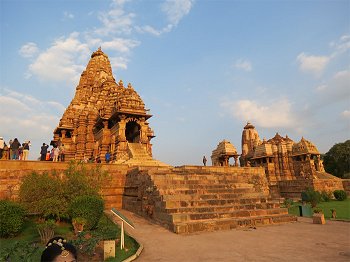
To the backdrop of Chitragupta temple dancers performed on a proper built stage. This year, additional well-designed structures in alignment with the Chitragupta temple were placed, which looked like various parts of the temple and dancers used the space often creatively. The lighting and the backdrop of Chitragupta temple created magic. With moon shining above in the clear sky surrounded by the stars and nip in the air, one indeed was transported to another world. The dance festival has succeeded in drawing tourists to Khajuraho in large numbers. Over the years, the small sleepy town that was Khajuraho now has several five star hotels with all the facilities. The town is connected by different airlines and also by rail. The Madhya Pradesh Tourism Dept has left no stone unturned to provide all facilities. As a result the dance festival draws international crowds. Since last few years, the festival is organized by Ustad Allaudin Khan Sangeet Evam Kala Akademy, Bhopal in association with MP Tourism Dept, South Central Zonal Cultural Centre, Chattarpur District administration and others. This year the admission was free with the result that there was a large turnout of local communities also. On average three dance forms, in solo, duet and group formations were presented. On three nights, four dance troupes were presented which did not go well with the audiences. The last troupes naturally performed before less number of spectators. The organizers would do well to limit to three dances or even better two dance forms each of one hour duration. 20th February 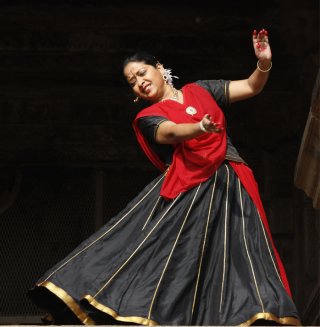 Sharmishtha Mukherjee
Dona Ganguly, disciple of Guru Kelucharan Mohapatra, presented Jatayu Moksha in Odissi. The male dancer Raghunath Das executed sharp movements intermittently. That did not jell well. The performance would have created more impact if Dona had not mixed contemporary movements by the male dancer. The story is well known. Impersonating Ravana, Sita and Jatayu, Dona displayed her sound training. Kelubabu's choreography has great appeal. Dona could also develop Rama's viraha with Kalidasa's slokas which have a great appeal. The star of the evening indeed was Uma Nambudripad Sathyanarayanan, a disciple of Chitra Visweswaran from Chennai. She did her guru proud. Beginning with Ananda Ganapati, Oothukadu Venkata Subbaiyer's prayer, with her graceful movements and an ability to cover the stage with typical Vazhuvoor bani, the utplavanas, jumps and going back swaying the body, she revealed the beauty of Bharatanatyam. In abhinaya to Purandaradasa's composition in 'nindastuti' format, asking "why are you not listening O Lord, you who saved Prahalada and also Draupadi," Uma displayed the emotions in a telling manner. With Madhurashtakam interwoven with tillana in Brindabani sarang composed by Visweswaran, Uma won the hearts of connoisseurs. The accompanists gave her excellent support. 21st February It was indeed a pleasure to watch Kathak by Tina Tambe, a disciple of Dr. Suchitra Haramalkar and Uma Dogra. Tina is enhancing her training through workshops of gurus like Pt Birju Maharaj, Pratap Pawar and other gurus. She has an arresting stage presence and succeeded in showcasing the salient features of both the Jaipur and Raigarh gharana in selected numbers in teen taal in vilambit and drut, performing with graceful movements. Shiva stuti in rupak taal was full of devotion. The finale with Hori created a joyous mood, playing with colour. Both in nritta and expressional numbers, Tina gave impression of her sound training. Dr. Suchitra Harmalkar accompanied her for padhant, recitation of mnemonics, and conducting the program. The impress of training under Uma Dogra was pleasant. It was also befitting that young generation gets an opportunity to perform at Khajuraho. French exponent of Mohiniattam, Brigitte Chataignier was asked to present her contemporary choreography of Ganga which she had successfully performed in a proscenium theatre with screening of Ganga river and other visuals. An attempt at uniting poetry, music and dance on an immense river, mythical, open to all whispers, echoes, a matrix of memories, with body undulating becoming water creating circulation of gestures et al , somehow even though it was for 35 minutes duration, the narration appeared too long and did not jell in the backdrop of Chitragupta temple. Accompanied by Mom Ganguly and a narrator, three of them had good co-ordination, but minus scenography, it did not leave impact. Instead Brigitte should have been asked to present Mohiniattam which would have given her an opportunity to display her command over Indian dance form. She has been living in Kerala for past twenty years dividing time between France and India and has imbibed the spirit of Mohiniattam in a delectable manner. I have seen her performances abroad and within India and would have loved to see her perform Mohiniattam. The contemporary choreography would better suit a proscenium theatre. 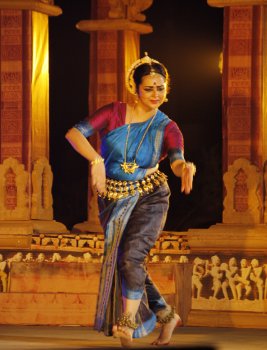 Sharmila Biswas The finale group dance Gati Vilas inspired by a Sanskrit verse commonly chanted by the rural mridanga players of Odisha described attributes of ideal performer comparing her gaits, stances and energies, expressions with those of different animals. Striding the space with power and speed of the horse, regal stillness of the lion, gliding with lightness of a swan, body vibrating with magical melody of the cuckoo, beauty of dance of peacock, and precision of a hawk. The entire choreography is full of these images exploring various characteristics of birds and animals in Odissi dance vocabulary. Sharmila and her group's performance was the highlight of the evening. 22nd February The find of the festival was a young and gifted Bharatanatyam dancer Anwesha Das, a disciple of Urmila Satyanarayanan from Chennai. Young, vivacious and versatile, she charmed the audience with her command over technique. Mallari in Gambhira Nattai performed during Lord Shiva's procession, followed by Natesha Kavutam were precise in movements. Surdas's 'Maiya mori main nahi makhan khayo', with a twist in the end saying naughtily that indeed "maine hi makhan khayo" - I did steal butter - was delectable. She concluded with Tillana in Dhanashri, Swati Tirunal's composition enhancing the joyous feelings of a nayika dancing, listening to the enchanting music, as described by the poet. Along with other musicians, Swamimalai Suresh conducted nattuvangam with finesse. The Odissi duet by Purnashree Raut and Lucky Mohanty dwelt on Guru Kelucharan Mohapatra's exquisite choreography of the' janana,' a composition of Muslim poet Salbeg, who was a devotee of Lord Jagannath. They enacted the sancharis of Gajendra Moksha, Draupadi vastrapaharana and Prahlada, how the Lord saved his devotees when they prayed to him. Salbeg begs of the Lord to give him glimpse of his divine beauty. The enactment was restrained and pleasant. Hamsadhwani pallavi saw them in various scuplturesque poses and symmetrical alignment of movements. Their standing side by side facing each other, at times one standing behind the other sitting on the floor etc., were imaginative. Finale with Devi Durga in her benign and ferocious moods was effectively enacted by Purnashree, whereas Lucky as Mahishasura displayed the valorous form. With Om Namah Shivaya, with formation of chaturbhuja image they concluded their presentation. I have seen them earlier at Mukteswar dance festival and both are doing well at Raipur in spreading awareness of dance. In terms of aharya, costume and head ornaments, Purnashri would do well to redesign it, so it does not look too heavy. Less ornamentation would bring out the beauty of Odissi movements. The musical support was of a high standard. It was good to see dancers from Raipur area. Kuchipudi by Srimayi Vempati, daughter-in-law of late Vempati Chinna Satyam, and her disciples displayed the typical quicksilver movements polished by Vempati, and was executed with precision, upholding the Vempati bani. Ashtapadi 'Pashyati dishi dishi' performed by Srimayi was in druta, fast tempo. It needs to be slowed down to let the bhava emerge. The graceful lyrical angikabhinaya, bodily movements were enchanting. Oothukadu's composition 'Marakata manimaya chela' for tarangam is a gem of choreographic piece by Vempati. The thali dance, performing on the rim of the brass plate by Srimayi and two female dancers Madhavi Namboodri and Meghana executing various typical pada bhedas, foot work, as seen in Kuchipudi, was very well conceived and executed. Shivashtakam by two male dancers Amarnath Ghosh and Shivakumar displayed vigour in their dance becoming of the dance of Shiva. Vempati's choreography brings forth various attributes of the great god residing at Kailasa. His splendorous majesty was enacted with speed. Both the dancers acquitted themselves well. The finale Mahishasuramardini with "Aii Girinandini" refrain had all dancers performing in a group, Srimayi playing role of Durga, the dancers alternating as asuras, the striking tableau like ending using the central shrine on the stage, framing the dancers, struck a strong visual. A team of musicians including Hanumanta Rao (nattuvangam), Gomati Nayakan (vocal), CV Sudhakar (flute) Narasimhamurty (veena) and Sarala Sarma (mridangam) gave able support. 23rd February The weather gods were not happy with us as on 23rd February it rained heavily, driving us all to the built in theatre of MP Tourism next to the temple. Though small, it was overcrowded and people thronged, sitting on the floor, and standing all around. It has a different kind of intimacy, as could be seen by the enthusiastic applause audience gave to each performer. Amrita Bewoor Sen, a disciple of Guru Kalyanasundaram Pillai of Raja Rajeshwari Bharatanatya Kala Mandir, Mumbai, renowned for Tanjore bani of Bharatanatyam, performed few numbers with complete fidelity to the Tanjore bani, as learnt by her from her guru, who conducted the nattuvangam. The Ganapati stuti with sculpturesque image of the elephant headed god, followed by an edited Varnam 'Sami ni' in which nayika requests her sakhi to bring Lord Shiva unto her, one who is incomparable, who when the rishis performed sacrifice and tried to attack Lord Shiva through emergence of a tiger, an elephant and a dwarf, did not succeed, one who drank poison when it emerged from churning of the ocean and was thus called Nilakantha, that Lord, the nayika begs her confidant to bring unto her. Amrita revealed the salient features of Tanjore bani with commendable ease. The accompanists, vocalist Vasanti Krishna Rao, Raghuraman on flute and Keshavan on mridangam gave her commendable support. Amrita has a commanding stage personality and expressive visage. With more rigorous practice and more opportunities to perform she is bound to make a name for herself. It is commendable that she has been combining practice as a doctor and performing classical dance form. Toronto based husband and wife duo Kathak exponents Hemant and Vaishali Panwar trained at Kathak Kendra under Rajendra Gangani, displayed their sound training of Jaipur gharana. Their thaat with gliding movements was impressive as was their pure dance pieces, incorporating various intra-forms chakkardar, ginati, parans, using Kavit to narrate the story of Govardhan and saragam to the solfa mnemonics tunefully rendered, showing their range of repertoire. Hemant would do well to organize his hair as they flew in all directions and created an unaesthetic look. Vaishali looked more poised. Together they performed with zest. Rajendra Gangani for padhant, recitation and Fateh Gangani on tabla gave them adequate support. Ananda Shankar Jayant from Hyderabad with her two disciples Sneha Magapu and Krithika Varsha presented Nritta Lahari using Kuchipudi and Bharatanatyam simultaneously and clearly displayed the difference in both dance forms. Tarangam, using brass plate for dancing on its rim, by Ananda won her rounds of applause. Vivacious and sparkling, her dance was lively and the audience, on account of the proximity, enjoyed it more than what they generally watch from a distance. Shivoham in Bharatanatyam by MP Jinakaraj and Sneha brought out the ardhanarishwara concept imaginatively. Jinakaraj is a bundle of energy, dancing with vigour, creating in a trice the powerful image of Lord Shiva. A competent team of musicians from Hyderabad, livened up the entire program, lustily cheered by the crowds, who after the performance thronged backstage to show their enthusiasm. Ananda is a mature dancer and brings a sense of programming to her presentation which has a touch of freshness. 24th February On Sunday, the weather gods were pleased and dancers performed at the venue with the backdrop of Chitragupta temple. Gopika Varma from Chennai presented two numbers in Mohiniattam. She has a striking stage presence and looks indeed like an enchantress, a Mohini. An ashtapadi 'Chandana charchita nilakalevara' to the melodious singing by Gomati Nayakan had a leisurely exposition. The confidante sakhi asks Radha to go unto Lord Krishna who is seen dallying with the gopis on the banks of Yamuna. Gopika's commentary did not go well with the depiction when she said that the sakhi had a hidden agenda, as she was also in love with Krishna. It would be appropriate to have a simple narration. Gopika's other presentation was Swati Tirunal's 'Chal man Kashi Vishweshwar darshan ko' in Sindhu Bhairavi. She depicted the cycle of birth and death competently conveying the message that none should have pride and ego. Look at what happened to Ganga when she was caught by Lord Shiva in his jata and she turned into a mere trickle of water! After the depiction of life and death cycle, to enact Ganga's plight, Gopika needs to introduce a connecting shloka as a link to bring out the message. Else it looks like a separate aspect and does not convey the intended message. Gopika's dance has allure and typical charm of Mohiniattam style. She has in her repertoire a well choreographed number Satyabhama garvabhangam (Satyabhama's pride vanquished), which will draw attention to her skills as a choreographer and bring added variety thematically. From Hyderabad, Kuchipudi dancer Sarala Kumari, a disciple of Dr. Nataraja Ramakrishna, presented Sanskrit composition in praise of Khajuraho, penned by Kavuta Manohar. The script and research were by Priya Rangarajan. The music was by Shashi Pritam. Two male dancers, exponents of Perini dance, revived by Nataraja Ramakrishna, interspersed vigorous nritta, with description. It did not go well with the main theme. It would have been better if they were presented separately showcasing the vigour and the tandava aspect of Perini dance. The description of Khajuraho temple, its sculptures, the shringara, the depiction of erotic element, nayikas, putting alta - red colour - on their feet, putting on ankle bells, in languorous poses, in physical union with the nayaka etc., were well conceived. Known as 'chinanshuka' in Sanskrit, the skin colour costumes designed by Sarala Kumari also did not appear appropriate. Instead she could have with her troupe introduced the wealth of sculptures, the dancers taking those poses. Sarala Kumari has spent a lot of time and resources for this project. Therefore it would be very helpful for artistic presentation to re-choreograph few aspects and make it an enjoyable presentation. Rohini Bhate's disciple Shama Bhate's troupe from Pune had to be accommodated during this evening, as they could not perform previous evening. She had a large number of dancers, 15 girls and one male dancer, all thoroughly trained and competent. Titled 'Infinite Kathak' it showcased Shama Bhate's choreography of the traditional numbers of Kathak in a seamless manner. Beginning with Nada-Vandana, the dancers gave glimpses of the rich repertoire of Kathak, gradually going from thaat to amad, in between tatkar, ladi, darjedar bols, gat nikas, bansuri, panghat, dancers with graceful swaying movements, forming several groups, combinations, smoothly moving from one end to another, entering from one end, and exiting from the other. Parmelu Shrinkhala could have been abbreviated. The Hori brought a joyous end. The music was well recorded and helped dancers to perform with good synchronization. Shama Bhate displayed her choreographic talents with a large group drawing attention to the fact that an open ended form like Kathak has great scope for new creations. From Chennai, A. Lakshmanaswamy and his troupe of Bharatanatyam dancers were the last performers. A young guru and a performer trained by KJ Sarasa he has earned recognition as a gifted solo dancer and choreographer. Beginning with Pushpanjali followed by Alarippu, Lakshman revealed his choreographic innovations with dancers performing Alarippu movements in square and circular formations. Muthuswami's 'Ananda natana prakasham' dwelling upon dance of Lord Shiva in Kedar ragam and mishra chapu tala had three male dancers bringing the Lord in a palanquin. The procession was shown with female dancers playing mridangam and other instruments, Shiva dancing in Chitta sabha and ending with Shiva - Parvati male and female dancers in an arresting pose. The Marathi pada 'Rusli Radha' performed by Lakshman and a female dancer was enjoyable. The sulking Radha and equally sulking Krishna finally reconcile and entire Vrindavan seems happy. The dancers concluded with Tillana in Kathanakutuhalam raga composed by M. Balamuralikrishna. They all performed in harmony and with precision. The musical component was highly enjoyable. Lakshaman and his troupe displayed excellent technique. 25th February The evening began with legendary Kathakali exponent Ramankutty Nair's son Appukuttan in role of Kirata from 'Kiratarjuniyam.' The story is from Mahabharata. When practicing penance to obtain pashupatasra from Lord Shiva, Arjuna is challenged by Shiva in a combat, in disguise as a forest dweller, Kirata. Parvati also in disguise as his wife begs of the Lord not to challenge Arjuna and in various ways shows her concern, requesting Shiva not to get angry and have pity on Arjuna. She also requests Arjuna not to lose his cool and avoid fighting with Kirata. But none listens and they fight. Arjuna falls unconscious. Lord Shiva blesses him for his valour and revives him. Realising that Kirata was none else but Lord Shiva, he bows to the couple and offers pranam, and Lord Shiva gives him Pashupatasra. The entire Kathakali presentation was highly enjoyable. Appukuttan Nair and other actors, in particular, the male dancer who played female role of Kirata's wife are well trained Kathakali exponents and succeeded in displaying their talent, keeping audience engaged in their presentation. Kathakali is indeed a complex dance-drama form. However, the selection of the story was more accessible to audience. Shailaja Nalwade, a Kathak Kendra dancer from Delhi, gave a scintillating solo performance with traditional intra-forms like thaat, amad, paran, jugalbandi and performed abhinaya to a thumri. Trained by a number of gurus including Urmila Nagar, Shailaja performs with confidence and has acquired, like her contemporaries, finish and a sparkle. Arriving on sam, the final poses with excellent movements of wrists, she captivated the audience with her polished performance. In Shiva stuti in raag Malkauns in chautal, she interwove the kavit "Jata juta math Ganga khalakat" and also displayed the swan gait of Paravati 'Hansagamani Parvati' making the presentation rich in images of Lord Shiva and his consort. The Jhula paran with sway of the swing, ginati, chakkaradar, paramelu and graceful Gat Nikas and accompanying flourishes of movements were enchanting. In thumri, she explored karuna and shringara rasa with her beloved's arrival and not letting him go. The jugalbandi as usual won her rounds of applause. A competent team of accompanists Akhilesh Bhatt (tabla), Mahavir Gangani (pakhavaj), Shamiulla Khan (vocal), Amir Khan (sarangi) and Uma Shankar (sitar) gave her good support enlivening her recital. Then followed an excellent presentation of seven classical dance forms conceived and choreographed by Odissi and Kathak exponent Parvati Dutta of Mahagami Gurukul, Aurangabad. She also arranged the musical accompaniment. The first number Nirgeet based on research work attempting to showcase the rich and varied dance vocabulary of the seven styles succeeded in a large measure as from abstract to concrete when Sangeet with verses in praise of Shiva were rendered, all seven dancers danced well, dressed in their regional costumes, and appeared absolutely stunning. I had seen this production at Ananya Festival in Delhi and had also the benefit of a post performance discussion. It helped me immensely to appreciate the hard work put in by Parvati and the dancers of different forms. The plus point is the maintenance of autonomy of each form, be it Kathakali, Bharatanatyam, Odissi, Kuchipudi, Kathak, Mohiniattam or Manipuri. Each dancer performed in tala and laya and the recording was well tuned, with the result the sound of each percussion instrument gave the feel of the form suitable for the dance style. 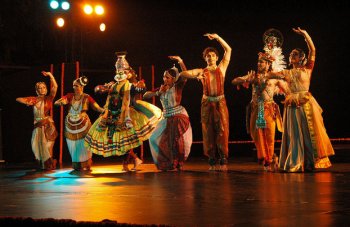 Sannidhi (Pic courtesy Mahagami)
I have been fortunate to have seen the performance by Prasiddha group of Bharatanatyam dancer Prathibha Prahlad during Delhi International Arts Festival. Led by Sathyanarayana Raju, a seasoned male dancer from Bangalore, the group including Madhuchandra, Aparna Shastri and Aditi Sadashiva, performed with gusto and excellent synchronization. They began with Mallari and Alarippu, followed by a solo by Sathyanarayana Raju to the Krishnakarnamrita shloka 'Gopa Gopi' in which he delineated several aspects of Lord Krishna, culminating into Krishna's Gitopadesha, revealing his Vishwarupa and asking Arjuna to do his duty and engage in the battle. Sathyanarayana has a commanding stage presence. The architectonic beauty of Bharatanatyam shines through his clean and arresting lines, geometrical formations of movements and dignified stance. He excelled in its presentation. 'Samagana lola' in Hindolam raga was performed by Madhuchandra, Aparna and Aditi. They incorporated Dashavatara and performed jugalbandi, between a male dancer and female dancers. 'Krishna mantra,' a dance number with its suggestive implication of 'gateway to Moksha' had interesting choreographic patterns. Performing with energetic movements, the dancers seemed to be enjoying it with bliss and knowledge that ultimately it is Lord Krishna to whose lotus feet one seeks resort and receives Moksha. 'Shri Krishna sharanam mamah' as a sacred mantra has universal appeal to all devotees. The finale Sargam saw all dancers in group choreography. 26th February The final evening featured three presentations. Kathak by Nirupama and Rajendra from Bangalore, Aloka Kanungo in Odissi from Kolkata and Uma Dogra and her dancers in Kathak from Mumbai. 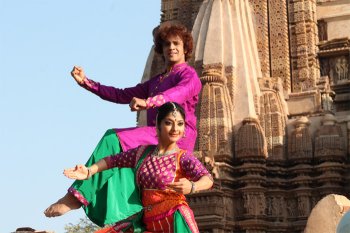 Nirupama and Rajendra
The couple entertained audience with sawal jawab. Dancing together for the past twenty four years, Nirupama said that she knows what answers her husband would give. Executing through foot work, tatkar, it was a lovely number laced with humour. The number which was most loved by audience was 'Ta dha,' the two mnemonic syllables to which they performed with lilting music, which had fusion of Afro Asian percussion, touch of jazz and classical Indian. The costumes were exquisite and both danced with joy, which was infectious. No wonder Nirupama announced that the young generation loves this particular number. I think it is so well choreographed, conceived and enhanced by music that its appeal is to one and all, leave alone the young generation. Nirupama and Rajendra's Kathak was one of the highlights of the festival. Aloka Kanungo, a disciple of Kelucharan Mohapatra, is a celebrated Odissi dancer. She has an endearing personality and performs with great fidelity to Kelubabu's style. Whether it is Mangalacharan, an ashtapadi from the Gita Govinda or a Pallavi, she lives up to her reputation and offers the audiences glimpses into the excellent choreographic work of the legendary guru. She lived up to her reputation when she performed Kamod Pallavi and ashtapadi 'Sakhi he Keshi mathanamudaram,' the first meeting of Radha with Krishna, describing her confusion, and feeling of bliss to her sakhi. She received good support from musicians including Prafull Mangaraj (mardala), Rupak Parida (vocal), Nirmal Nayak (violin) and Abhiram Nanda (flute). Live music always gives a feeling of complete performance. Aloka is a petite beauty and succeeds in conveying her perfect movements and subtle expressions she registers on her face with total involvement. 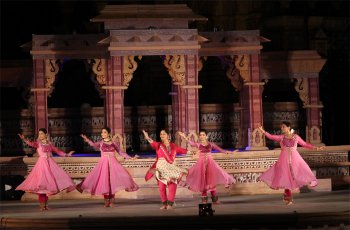 Uma Dogra and her disciples
The finale was by redoubtable Kathak performer Uma Dogra and her disciples from Mumbai. Uma Dogra brings to her recital an old world charm. She laces her comments with Urdu shayari, establishing at once a rapport with her audience. She has a charming way of introducing her musicians and creates a friendly feeling. Her accompanists Shailendra Bharati (vocal), Sandeep (sarangi), Uma Shankar (sitar) and Abhiram Nanda (flute) were in fine fettle. If Uma could not see the audience, she would request organizers to give more light on audience, so she could see the response of her admirers. She would talk with the audience, which is her winning point. In Devi Durga stuti along with her disciples, she created images of multi-armed goddess. She used the central shrine on the stage framing the image which looked awesome. She incorporated kavit on Durga with epithets of Simhavahini, Bhavani, Rudra ardhangini, Shumbhavidarini and so on. She followed it with traditional Kathak nritta numbers in teen taal vilambit laya, demonstrating angika uthan, which her late guru Durgalal used to perform with grace. Keeping palm on shoulder and one arm above head, she moved gracefully. Chhoti thaat, flawless chakkars, amad in three tempo, Mohanrao Kallianpurkar's composition and taking 21 chakkars, pirouettes, coming on sam with dha, she regaled the audience with Jaipur gharana Kathak. Enacting abhinaya to Surdas's bhajan 'Shyam tori Bansari nek bajau' -' I shall play your flute O Krishna' - in her own individual style incorporating extra compositions of musicians Rajan and Sajan Mishra, the melodious singing by Shailendra Bharati, the stanzas like 'tum dadhi bechan jao Brindaban, ham mag rokan aaun' - ' I shall make you go to sell curd in Brindaban and I shall obstruct your path' - Surdas says 'Prabhu tum jo Radhika, main Nandalal kahavun' - 'you become Radhika and I Krishna!' She concluded with Tarana with her disciples in Megh raga composed by Shailendra Bharati, replete with Kathak bols, including gats like Bindi ki gat, Ghunghat ki gat, and various chakkars, bringing the recital to a resounding end. This year Khajuraho festival of dances was a marathon dance event with too many dancers. Though it is a welcome step to give opportunities to young up and coming dancers, too many dancers posed problems in terms of scheduling and timing in one evening. If the performances extend beyond 9pm, the audience starts leaving the venue. Therefore a solution would be to have maximum three dancers per evening, one up and coming dancer, who should be given 35 minutes to display his/her talents and the other two sets of dancers be given forty five minutes each. That would help sustain interest and would save dancers facing thin audience in the end. The selection also needs tightening of the standards, so the reputation the festival has built up for the past 38 years is kept up and it needs to raise the bar. Shri Lakshmikant Sharma, the Minister for Culture, Govt. of Madhya Pradesh is an enlightened person and has been taking personal interest in the development of cultural activities, supported by the present team of organizers including Director Ganesh Bhalchandra Bagdare, Rahul Rastogi, Vivek Tembe, announcer Sunil Vaidya, and others of long standing, associated with the festival for many years. Indeed they have put their hearts into making this festival a success as was witnessed in large turnout of the crowds and several new features like exhibition of Kathakali, paintings and Art Mart, textiles and handicrafts. The brochure is also well designed and is a collector's item. One looks forward to attending the forthcoming 40th edition of Khajuraho Dance Festival. 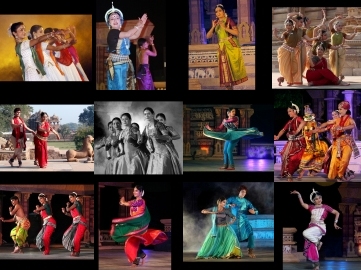 View slide show  Dr. Sunil Kothari is a dance historian, scholar, author and a renowned dance critic. He is Vice President of World Dance Alliance Asia Pacific India chapter, based in New Delhi. He is honored by the President of India with Padma Shri, Sangeet Natak Akademi award and Senior Critic Award from Dance Critics Association, NYC. He is a regular contributor to www.narthaki.com, the roving critic for monthly magazine Sruti and is a contributing editor of Nartanam for the past 12 years. Response * Excellent review, analysis and suggestions. As they say two is good company and three is a crowd. I feel the earlier format of restricting the performances to two a day would be better. By the way, what happened to the folk dance festival that used to happen simultaneously and in fact attract more crowds? - G Ulaganathan (Apr 7, 2013) Post your comments Pl provide your name and email id along with your comment. All appropriate comments posted with name and email id in the blog will also be featured in the site. |